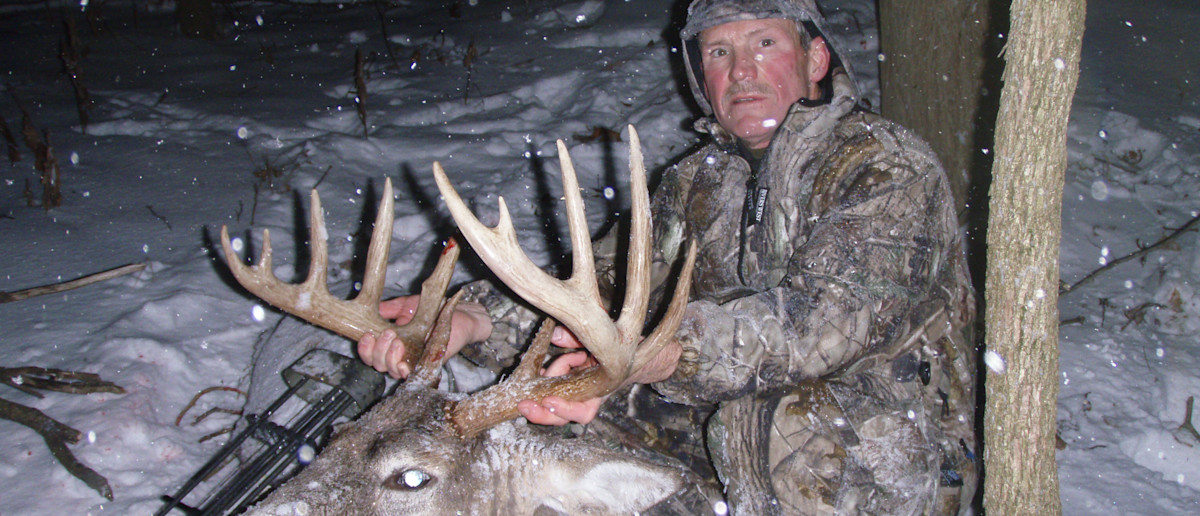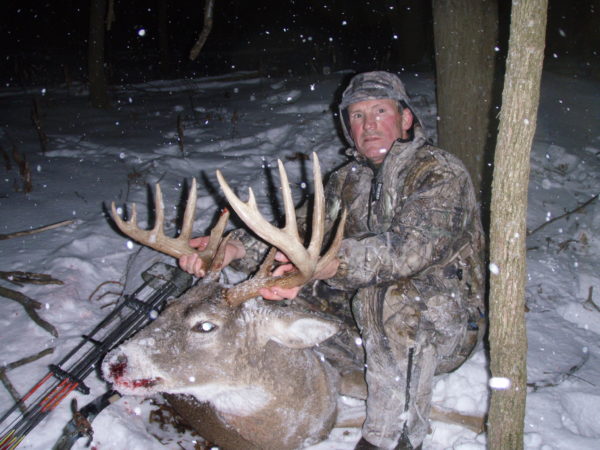
If you enjoyed Episodes #62 and #159 of the Wired To Hunt Podcast with John Eberhart, you’re in for a treat. Over recent months, we’ve been sharing a number of John’s successful kill stories and today we’re back with another. John’s detailed description of his hunts and plans offer a rare chance to get into the mind of one of the most seasoned and successful DIY bowhunters in the country. Take this opportunity to really process what he does and why he does it. Enjoy. – MK
By John Eberhart
After bowhunting from trees for fifty plus years without incident my only big fall was in my driveway. In February 2008 I slipped on a patch of ice while shoveling snow and while falling face first towards the concrete I turned my right shoulder into the impact. I would have been better off landing on my face as at impact I felt and heard a rip.
The muscle group and tendon on my right shoulder had torn completely loose from my shoulder bone. I stood and tried to make the few steps to the house, but couldn’t make it. Sliding the side door of my minivan open I passed out in the back.
Being 57 years old at the time, I was getting to the point where I needed rotator cuff surgery anyway, but this surgery would be way more invasive than that. After arthroscopic surgery to repair the typical rotator cuff issues, my shoulder was opened up and several screws were placed to hold the muscles and tendon in place. Upon reviewing the pictures of the actual surgery that the doctor gave me, she had also tied my entire upper arm bone and shoulder bone together with what looked to be a thin blue rope, so that it could not move. The surgery pictures sort of reminded me of my days as a boy scout learning how to tie knots.
After 14 weeks in a sling I started physical therapy and due to the total lack of use, when I held my arm out to make a muscle, my skin drooped like an old man. Therapy went extremely well with minimal pain, but it was obvious there was no way I was going to pull my sixty pound Mathews Conquest bow by the October 1st Michigan opener.
I called Ron Cormier at Mathews and begged him to make me a 30 to 40 pound, 60% let-off Conquest bow. After bothering him continuously, he gave in and had one made just to get me off his back. Next came the task of acquiring new arrows and smaller cut broadheads that would have sufficient speed and penetration out of a thirty-pound bow to hopefully kill a whitetail.
For arrows I used Carbon Express – Maxima Hunter 150s with feathers as I’m a fingers shooter. I had been shooting G-5’s Tekan II mechanical heads but switched to G5’s 100-grain, 1 1/8 inch cut, fixed blade Strykers. The 150 Maxima Hunters tipped with Stryker heads shot like little darts out of that Conquest bow at thirty pounds and their accuracy was awesome and by the season opener I had worked my draw weight up to a whopping thirty five pounds.
Climbing trees was a chore as I struggled pulling my body weight up with my right arm. There was also some concern that I might pull everything loose again and have to start the whole process over.
During the month and a half of bow season leading up to the Michigan gun season I hadn’t seen a buck that would score over 100 inches. I’d passed on a couple 2 ½ year olds, but in central Michigan it generally takes a buck at least 3 ½ years to grow decent antlers.
On November 21st with my son Jon, we traveled to Kansas where he took a giant eight point and I went home empty handed. To say the least it had thus far been a depressing season for me. The first test of my equipment came in early December when I took a doe for the freezer and it worked perfectly.
I had applied for an Illinois tag for a hopeful December bowhunt and watched the weather for snow. On December 14th (the last day of the Illinois gun season) the extended forecast for central Illinois was for snow, extreme winds, and extreme cold. That is exactly the weather conditions I was looking for and I called an open-to-hunting state park ranger to confirm they were beginning to get the weather. While the snow hadn’t come in yet, they were getting the winds and frigid temperatures, so along with friend Russ Clark we packed our gear and departed to Illinois.
We arrived at the park at 10 am and to say the weather was absolutely miserable would be an understatement. We scouted the entire day and prepared three locations, two in bedding areas that would require two hour prior to daylight entries, and one near a locust tree where deer had been pawing up and eating the long black beans it dropped. Preparing locations with Russ was nice because we both hunt from saddles so we could both hunt from the same set-ups.
The weather report was spot on and while it was single digit temperatures and thirty mph winds, it had not snowed yet. Not being completely happy with our three locations we blew off the next morning to scout and we set up 2 more locations. Just as we were finishing the last location it started to snow.
We went back to the motel, cleaned up, and went hunting. The temperature was seven degrees, there were 30 plus mph biting winds, and it was snowing sideways. We knew what we were getting into and were totally prepared. Our Rivers West Ambush suits negated the wind and kept us dry and the five strategically placed Grabber Adhesive Body Warmers we each wore kept our core body temperatures and heads toasty warm.
I was perched 28 feet up a maple tree, twenty yards from a locust tree. I chose the locust because the year before I had taken a 9-point from a different Illinois state park in December and he came in to a locust tree as well.
The 360-degree mobility of the saddle allowed me to swing around the tree and place my nose against its large trunk as a wind block for my face. The wind was so strong that I rarely pulled my face away from the protection of the tree trunk to look for approaching deer. My peripheral vision was focused beneath the locust tree.
The deer weren’t moving and I didn’t blame them as the weather wasn’t fit for man nor beast. Then about a half hour before dark I heard a twig snap below me and turned my face into the wind to see a three and a six point, followed closely by an eight point. They passed and meandered out of sight into the timber. When I put my head back behind the tree trunk my eyes began watering profusely from the bitter cold wind.
No sooner did the group of subordinate bucks disappear a respectable ten pointer stepped beneath the locust tree. He didn’t eat any beans, but sniffed the ground as if searching for a receptive doe. I was amazed that suddenly all these bucks were on the move during such inclement weather conditions and at one point, I considered taking the twenty yard shot.
Through the whiteout of snow I could make out another buck with three does behind him coming directly towards the locust. This was unbelievable, I was on state land only three days after gun season and I had now seen five bucks and as he approached it was obvious that he was a definite shooter.
I swung to the shooting position, pulled my hands out of my muff and slowly lifted my bow off its hanger. The buck steadily progressed and within thirty seconds was eighteen yards and slightly quartering to me. I expected him to stop and eat beans, but he didn’t so I hurriedly came to full draw and vocally matted to stop him, but due to the strong wind he didn’t hear me. I matted again a bit louder, no response. He was now at fourteen yards, broadside, and still moving. Two more steps would put him behind brush and would be a lost opportunity. My last vocal matt was loud and he heard it, stopped abruptly, and looked around for the source.
It had been a long spring, summer and fall wait for this opportunity and it would be at a spectacular animal. In my panic to get him to stop I forgot to check my bulky clothing for string clearance once at full draw. Fortunately the clearance was fine and the arrow flew true and found its mark right behind the buck’s front shoulder. As the buck ran through the open timber he began to disappear in the blizzard of snow, but just before he went out of sight he expired headlong into the snow.
I immediately lowered my equipment and went over to see what he had for headgear and in those few brief minutes he was covered with snow. His left antler was sticking up and it had fix perfect tines sticking up off the main beam for a total of six points and when I pulled his head out of the snow, the other side was a perfect match, a rare, clean typical twelve pointer.
Russ hunted for two more days without seeing anything he wanted to shoot and then on the morning of the 19th we woke up to a severe ice storm. There was a quarter inch of ice on everything and the weather forecast was for more winter storms across the Midwest and Northeast, so we headed to the woods and very carefully, because everything was coated in ice, took our strap-on steps and climbing sticks down, went back and packed, and went home.
This hunt came together very well for me and Russ as well because he had never hunted in weather anything remotely close to this and was happy with the thought that he now could and had the right clothing and gear to do so.

Bowhunting for whitetails is all about persevering and hunting no matter the conditions because deer can’t pack their belongings up and go inside, they have no option but to deal with what Mother Nature deals them.
Editors note: John Eberhart is an accomplished bow-hunter that specializes in heavily pressured areas with 29 bucks listed in CBM’s record book from 19 different properties in 10 different counties. John produced a 3 volume instructional DVD series titled “Bowhunting Pressured Whitetails” and co-authored the books, “Bowhunting Pressured Whitetails”, “Precision Bowhunting”, and “Bowhunting Whitetails the Eberhart Way”. They are available at www.deer-john.net, where you’ll also find information about his new whitetail workshops.




